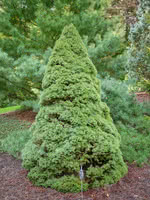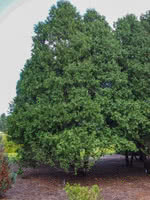Mon-Fri 9am - 5pm Mountain time
Dwarf Alberta Spruce vs Eastern White Cedar (Arborvitae)
Picea glauca conica
Thuja occidentalis
Dwarf Alberta Spruce is a small tree with very dense foliage. It is an attractive specimen in landscape designs and small yards. This plant naturally grows into the classic conical shape, but responds well to shearing and pruning.
Dwarf Alberta Spruce is hardy and disease resistant. However, its thick foliage can collect mildew. Consider planting this tree in an open space where the wind can dry out its needles.
You can use this cultivar as a substitute for cedar or juniper.
Eastern White Cedar is a slender growing conifer often used as a decorative tree or a hedge. This tree is an effective privacy screen even in winter and a great long term solution to urban crowding or a drab yard.

